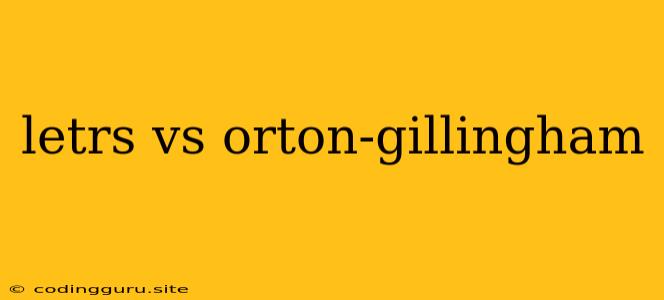The Great Debate: LETRS vs. Orton-Gillingham
For educators and parents alike, the quest for the best approach to teaching reading can feel like a treasure hunt. Two prominent methods often emerge as potential solutions: LETRS (Language Essentials for Teachers of Reading and Spelling) and Orton-Gillingham. Both methodologies boast impressive track records in helping struggling readers, yet they employ distinct approaches. So, which one reigns supreme? The answer, as with many things in education, is not a simple one-size-fits-all. Understanding the nuances of each method can help you determine the best fit for your needs.
LETRS: A Comprehensive Framework
LETRS stands for Language Essentials for Teachers of Reading and Spelling. This research-based approach, developed by Louisa Moats, emphasizes a deep understanding of the relationship between language and reading. It delves into the science of reading, focusing on the foundational skills that underpin literacy success.
LETRS aims to equip teachers with a comprehensive framework that empowers them to:
- Master the Science of Reading: This includes understanding the key components of reading, such as phonological awareness, phonics, fluency, vocabulary, and comprehension.
- Apply Research-Based Strategies: LETRS provides evidence-based strategies to address reading challenges and promote reading development.
- Differentiate Instruction: It empowers teachers to tailor instruction to meet the individual needs of learners, ensuring every student has access to effective learning opportunities.
Orton-Gillingham: A Multisensory Approach
Orton-Gillingham is a structured, multisensory approach to reading instruction, often used for students with dyslexia and other learning disabilities. It was originally developed by Anna Gillingham and Samuel Orton in the early 20th century.
Orton-Gillingham utilizes a multisensory approach, engaging students through:
- Visual: Visual cues like letter shapes, colors, and symbols
- Auditory: Spoken words, sounds, and rhymes
- Kinesthetic: Tactile activities, such as tracing letters and manipulating objects
- Motor: Fine motor skills like writing and manipulating manipulatives
Key Features of Orton-Gillingham:
- Explicit Instruction: Teachers systematically break down language skills and provide clear explanations.
- Diagnostic-Prescriptive: It involves assessing students' strengths and weaknesses and then tailoring instruction accordingly.
- Systematic and Cumulative: The program progresses gradually, building upon previously learned skills.
LETRS vs. Orton-Gillingham: A Closer Look
While both approaches share a common goal of fostering reading proficiency, their strengths and weaknesses lie in different areas:
LETRS:
Strengths:
- Comprehensive: Covers a broad range of reading skills and concepts.
- Research-Based: Draws heavily on the science of reading, providing a strong theoretical foundation.
- Teacher Training: Provides comprehensive training for teachers, equipping them with the knowledge and skills to implement the program effectively.
Weaknesses:
- Less Individualized: May not be as tailored to individual learners' needs as Orton-Gillingham.
- Focus on Language: While important, it may not address the specific challenges of students with dyslexia.
Orton-Gillingham:
Strengths:
- Highly Individualized: Can be adapted to meet the unique needs of each student.
- Multisensory Approach: Engages multiple senses, which can be particularly beneficial for students with dyslexia.
- Proven Effectiveness: Extensive research supports its efficacy for students with reading difficulties.
Weaknesses:
- Costly: Can be expensive to implement due to the need for specialized training and resources.
- Time-Consuming: May require significant time and effort to master the program.
Choosing the Right Approach: A Matter of Context
Ultimately, the decision of whether to use LETRS or Orton-Gillingham depends on a variety of factors, including:
- Student Needs: Consider the specific needs and challenges of your students. If they have severe dyslexia, Orton-Gillingham might be a better choice.
- Teacher Expertise: Make sure your teachers have the necessary training and expertise to implement the program effectively.
- School Resources: Consider the availability of funding, time, and other resources to support the program.
Leveraging the Best of Both Worlds
There's no need to choose one over the other. LETRS and Orton-Gillingham can be complementary approaches. LETRS can provide a solid foundation in the science of reading, while Orton-Gillingham can provide targeted intervention for students with specific challenges.
Beyond the Debate: A Holistic Approach
The key to successful reading instruction lies in a holistic approach that addresses the needs of every learner. This means:
- Early Intervention: Identifying and supporting struggling readers as early as possible.
- Assessment and Monitoring: Regularly assessing students' progress and adjusting instruction as needed.
- Collaboration: Working closely with parents, specialists, and other educators to create a cohesive support system.
In Conclusion:
LETRS and Orton-Gillingham are both valuable tools in the fight against illiteracy. By understanding their strengths and weaknesses, educators and parents can make informed decisions about the best way to support struggling readers. The key is to choose the approach that best meets the unique needs of each student and to create a supportive learning environment where all learners can thrive.
